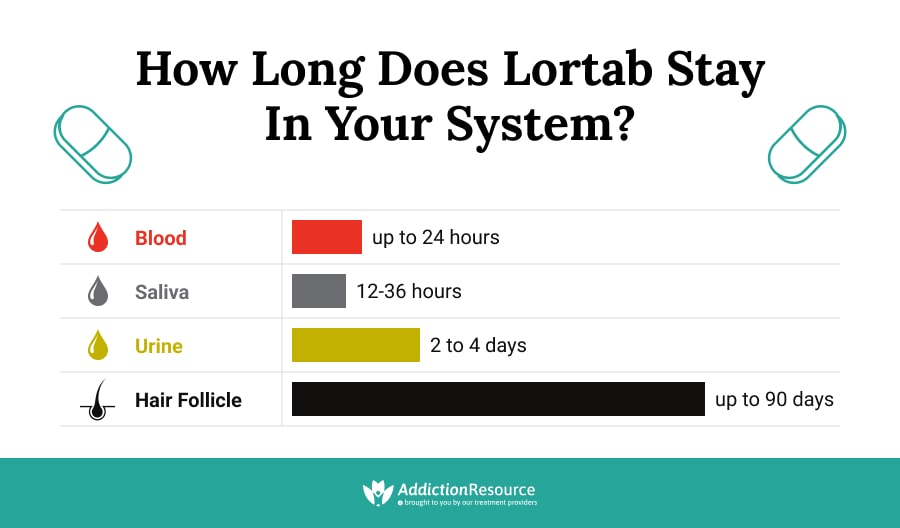
Lortab is routinely prescribed for easing moderate to severe pain. It combines two different components, which counter pain and use different mechanisms of action. Although strict guidelines are in place, Lortab addiction is common due to its opioid component, hydrocodone. Millions of people in the U.S. are dependent on prescription opioids. Moreover, Lortab side effects and pregnancy risks are the health problems many patients are dealing with.
Table Of Contents:
When one is starting opioid pain treatment, it is vital to have vital information about the drug, how it looks, and how the signs of addiction can be recognized.
So, what is Lortab? What are its side effects? What are the dangers of mixing Lortab and alcohol? And how long does Lortab stay in your system?
What Is Lortab?
Lortab is a type of prescription medication provided to individuals with pain symptoms. Users should understand that this medication combines two different chemicals:
- Hydrocodone is the first chemical that is found in this particular drug. It is a type of opioid.
- The other ingredient that is combined with the Hydrocodone is Acetaminophen.
While the use of this medication is considered effective, there are certain factors that patients need to take into account. Whether the generic form is used or the actual brand name option, it is crucial to consider Lortab side effects and precautions.

More About Opioids:
The drug is available in a tablet form as well as Lortab elixir, which is an oral solution.
While a decline in the prescription of this medication and other solutions that combine Acetaminophen and Hydrocodone has been noted in Emergency Departments, the drug still remains a popular prescription option for individuals with pain-related symptoms.
Lortab Generic and Brand Names
While a Lortab elixir is a popular option to help alleviate pain symptoms, it is essential to notice that it does not always go by this particular name. Other names are sometimes used to describe the combination of hydrocodone and acetaminophen.
Lortab generic name is hydrocodone/acetaminophen.
However, There Are Other Brand Names of the Same Drug Available, Such As:
In some cases, additional ingredients are added, or the concentration of the components is altered. In such scenarios, the dose should be compared to other drugs like Vicodin ES or Vicodin HP and formulations like Lorcet Plus and Lorcet HD.
Mixing Lortab and Alcohol
Alcohol is well-known to be ill-advised for patients dosing on most types of drugs, and this medicine is no exception. Using alcohol while taking opioids will cause an unnatural spike in the likelihood and severity of adverse health effects experienced by the user.
Lortab and alcohol are both CNS depressants, and their concomitant use can depress the nervous system to a dangerous level.
The Dangers of Mixing the Two Are:
- Trouble breathing
- Weak pulse
- Slurred speech
- Loss of consciousness
- Impaired coordination
- Dizziness
- Drowsiness
- Memory loss
Lortab and alcohol are both known to be highly addictive, and when used together, there is a higher risk of developing an addiction to them. Overdose is also a possibility. If any signs of abuse are noticed, professional addiction treatment is necessary.
Lortab Side Effects
As previously said, this medication contains a combination of hydrocodone and acetaminophen. It comes in different dosage strengths, such as Lortab 10 mg and 7.5 mg. It is essential to notice that the higher the dose, the greater the chance for Lortab side effects.
Common Side Effects of This Painkiller Are:
- Anxiety
- Nausea And Vomiting
- Mood Swings
- Blurred Vision
- Low Blood Pressure
Lortab elixir is likely to mess with one’s digestive system as well. It can cause an upset stomach for some people, while for others, it can cause constipation.
Long-Term Effects
Repeated use of opioid drugs for a prolonged duration can have severe health problems. Frequent use of hydrocodone is likely to result in the body getting used to the dose of the drug taken. As a result, it will stop responding to that dose after some time, and to get the same effect, the user will have to take a higher dose.
Other Long-Term Effects Include:
- Acetaminophen Toxicity And Liver Damage. Like some other painkillers, this one also contains acetaminophen, which is known to cause liver damage in many cases. Repeated use of acetaminophen can even lead to liver failure in extreme cases. The user will then need a liver transplant.
- Sexual Problems. This opioid has also been associated with sexual problems. One of the Lortab side effects in men is loss of erection and sexual desire, while in women, it may lead to reduced fertility.
- Sensorineural Hearing Loss. This is a type of hearing loss in which the root cause is hearing hallucinations in the inner ear.
Dangers of Lortab While Pregnant
Women experiencing pain during pregnancy must be cautious when taking it because this painkiller can harm the health of the mother and the fetus. This information is vital as it can prevent medical emergencies from happening.

If an expectant mother takes a higher dosage of this drug than required, especially during the first trimester, she is likely to develop a physical tolerance to it and may even become addicted to the drug. As a result, the unborn child can become physically dependent on the drug, which can pose serious health concerns after birth.
Lortab while pregnant in the first trimester is associated with a higher risk of developing a neural tube congenital disability. This fact was mentioned in a study dedicated to the periconceptional use of opioids and the risk of neural tube defects.
Use of drugs such as Percocet or Lortab while pregnant can lead to Neonatal Abstinence Syndrome (NAS) or Neonatal Opioid Withdrawal Syndrome (NOWS).
However, if acetaminophen is used alone during pregnancy, it is considered safe. This is because it is not habit-forming and not as potent as hydrocodone. That is why pregnant women should look for safer alternatives for pain management. These include acetaminophen, available under the brand name Tylenol.
Breastfeeding
Nursing mothers should be very cautious when taking opioid-based painkillers, as the active ingredient in the drug can be transferred to the baby through breast milk.
Consult your doctor regarding the use of Lortab while pregnant or breastfeeding. Never try to self-medicate to avoid dangerous consequences.
Common signs and symptoms of opioid overdose in a baby include difficulty breathing, increased drowsiness, and limping. All these symptoms signify a medical emergency and indicate that the baby needs immediate medical attention.
Lortab Addiction and Withdrawal
As this drug consists of an active chemical classified as an opioid, a concern regarding the possibility of developing a dependence on the medication arises. Addiction to Lortab elixir is highly possible. Also, when a person takes too much of this medication and suddenly stops, the individual falls under the risk of experiencing Lortab withdrawal symptoms.
The Withdrawal Symptoms Include:
- Depression. Many individuals report extended periods of depression linked to Lortab withdrawal. However, with codeine the risk for depression is higher.
- Insomnia. Opioid drugs are natural depressants and are often recommended to help insomniacs to fall asleep. A shortage or absence of the drug in the system may lead to difficulty in sleeping at night.
- Muscle And Joint Pain. The abrupt drop in levels of endorphins in the system due to Lortab withdrawal can cause varying levels of muscle and joint pains. In some cases, the pain can be extreme and requires the urgent attention of a medical specialist.
- Palpitations And Panic Attacks. This is because the drug mainly acts as a depressant, which slows down or regularizes heart activity. The absence of the medication can lead to an escalation in heart rate as well as increased anxiety.
- Abdominal Cramps. The discontinuation of an opioid, which is the main ingredient, can cause severe cramps in the abdomen and the other areas of the body, which can be highly discomforting.
- Tiredness. Overwhelmingly constant fatigue is experienced, especially in the initial weeks of cold turkey. It happens due to an upsurge in the nervous system activity while trying to maintain a relatively constant internal routine. The change in endorphin levels and neurotransmitter activities is also a factor.
- Loss Of Appetite. One is likely to experience a significant reduction in appetite, especially in the first few days of withdrawal.
- Drug Craving. It is typical to experience a high craving for the drug, which will cause severe discomfort and psychological trauma. This stage can be a bit extreme; however, with the correct addiction treatment, these cravings will subside.
- Diarrhea. One of the side effects of taking Lortab elixir is constipation, and in reverse, diarrhea is a symptom of complete withdrawal from the drug.
- Headaches, Dizziness, And Vomiting. These combined flu symptoms are typical of withdrawal from the drug. They are usually experienced quite early in the withdrawal stages.
- Severe Itching. Itching is caused by the activation of nerve endings under the skin due to withdrawal. The nerve endings become extremely sensitive, causing severe itching.
- Mood Swings. During the withdrawal phase, an individual may experience high irritability due to the adjustment and transitioning of the nervous system. The mood swings may continue for days depending on the levels of dependency.
- Suicidal Thoughts And Behavior. The imbalance in the levels of endorphins and the absence of mu- receptor stimulation can lead to reckless thoughts and behaviors that may have dire consequences.
- Profuse Sweating. The skin may sweat many times during the day. This is a triggered self-detoxification mechanism and is quite common during withdrawal.
People may also sometimes consider going to the extreme and using methods other than simply taking the pills. For example, it is not uncommon to find someone snorting Lortab pills once they have developed an addiction to medicine. But this practice is highly dangerous and causes far more side effects.
How Long Does Lortab Stay In Your System?
To understand how long the medication stays in one’s system, it’s required to know Lortab half-life. That includes the half-life of its two components: acetaminophen and hydrocodone.
Acetaminophen half-life can vary between one and three hours. Hydrocodone half-life has been documented to last for 3.5 hours. However, anecdotal reports indicate that it can take up to 9 hours before the medication disintegrates and becomes eliminated from the body.

So, how long does Lortab stay in your system? With reference to the half-life period, it may take this drug up to three days before it is excreted from the body.
Withdrawal effects may appear after about 6 up to 12 hours from the last intake.
Duration in Urine
Urine tests can show the presence of opioid drugs when conducted 2 to 4 days following the last dosage. Still, it generally depends on how long it takes for the body to excrete the active components of the medication.
Duration in Blood
A drug test using blood as a specimen can detect opioid components for up to 24 hours only.
Duration in Hair
A hair follicle test will show the use of opioid components for up to 90 days since the last dose was taken.
Duration in Saliva
Opioids are known to be detected in the saliva if the test is done between 12 and 36 hours from the last intake.

The fastest way to flush the substance from the body and break free from addiction is to seek medical treatment. Early detection of possible addiction and abuse will help to drive a patient through detoxification and treatment successfully. Otherwise, there is a risk of overdosing on the drug. As it is a combination medication, it’s possible to overdose both on hydrocodone and acetaminophen. The Centers for Disease Control and Prevention names hydrocodone as one of the top three causes of death due to prescription opioid overdose.
Signs of a Lortab Overdose Include:
- Cold or Clammy Skin
- Constricted Pupils
- Cyanosis
- Hyperalgesia
- Dizziness
- Drowsiness
- Nausea and Vomiting
Opioid overdoses can be deadly, so it is important to seek medical help once any of the symptoms become seen.
Addiction Treatment
Perhaps one of the most dangerous long-term Lortab side effects is an addiction. This is because Lotrab contains hydrocodone, an opiate or narcotic similar to drugs like codeine, heroin, and morphine. The problem with hydrocodone is that there is always a risk of addiction, even if the user is taking the drug as prescribed by the doctor. There is also a risk of alcohol addiction related to this prescription drug, as it contains a small amount of alcohol.
So, the first step in the treatment process of addiction to this drug is detoxification. Drug detox is necessary to remove all the compounds of this drug from the system. After that, a drug test can be done to ensure that any components of Lortab elixir are not in the system anymore. If any signs of dependency were noticed, the person should enroll in rehabilitation programs or Methadone clinics that can help individuals completely recover from their addictions, no matter how severe they may be.
Hope Without Commitment
Find the best treatment options. Call our free and confidential helpline
Most private insurances accepted
Find Drug Rehabilitation Centers Near You Anywhere In the US
Addiction Resource team has compiled an extensive list of the top drug rehabilitation facilities around the country. Use our locator tool to find the best centers near you.
Page Sources
- Grasso, M. A., Dezman, Z. D., Comer, A. C., & Jerrard, D. A. (2016). The decline in hydrocodone/acetaminophen prescriptions in emergency departments in the Veterans Health Administration between 2009 to 2015. Western Journal of Emergency Medicine, 17(4), 396. https://www.ncbi.nlm.nih.gov/pmc/articles/PMC4957666/
- Yazdy, M. M., Mitchell, A. A., Tinker, S. C., Parker, S. E., & Werler, M. M. (2013). Periconceptional use of opioids and the risk of neural tube defects. Obstetrics and gynecology, 122(4), 838. https://www.ncbi.nlm.nih.gov/pmc/articles/PMC4557737/
- DailyMed, LORTAB- hydrocodone bitartrate and acetaminophen tablet, https://dailymed.nlm.nih.gov/dailymed/drugInfo.cfm?setid=1fb18a80-8ef0-4bce-bb0d-9a86851c5206
- Centers for Disease Control and Prevention,Prescription Opioid Data, https://www.cdc.gov/drugoverdose/data/prescribing.html
- Agrawal, S., & Khazaeni, B. (2020). Acetaminophen toxicity. Statpearls [internet]. https://www.ncbi.nlm.nih.gov/books/NBK441917/
- Centers for Disease Control and Prevention, About Opioid Use During Pregnancy, 2021. https://www.cdc.gov/pregnancy/opioids/basics.html
- Clinical Guidelines for Withdrawal Management and Treatment of Drug Dependence in Closed Settings. Geneva: World Health Organization; 2009. 4, Withdrawal Management. Available from: https://www.ncbi.nlm.nih.gov/books/NBK310652/
- Scherrer, J. F., Salas, J., Bucholz, K. K., Schneider, F. D., Burroughs, T., Copeland, L. A., ... & Lustman, P. J. (2016). New depression diagnosis following prescription of codeine, hydrocodone or oxycodone. Pharmacoepidemiology and drug safety, 25(5), 560-568. https://www.ncbi.nlm.nih.gov/pmc/articles/PMC4904297/
- Valtier, S., & Bebarta, V. S. (2012). Excretion profile of hydrocodone, hydromorphone and norhydrocodone in urine following single dose administration of hydrocodone to healthy volunteers. Journal of analytical toxicology, 36(7), 507-514. https://pubmed.ncbi.nlm.nih.gov/22782534/


 Reviewed by:
Reviewed by:  Written by:
Written by: 


 FindTreatment.gov
FindTreatment.gov